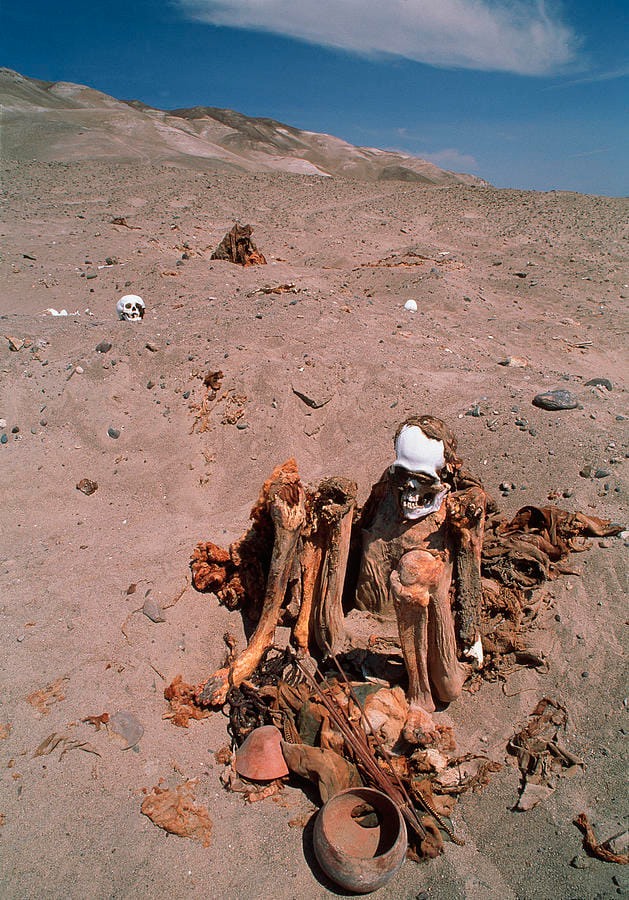Mummification is an ancient practice that served as a bridge between the living and the dead, allowing the deceased to remain an active part of their community. In Peru, this tradition spanned over 7,000 years and was practiced by numerous cultures throughout the region. By preserving human remains with meticulous care, these ancient civilizations ensured that the dead could continue to interact with the living, providing us with a rare and insightful glimpse into their spiritual and cultural beliefs.
In ancient Peru, mummification was not merely a method of preserving bodies; it held deep cultural and spiritual significance. Mummies were often kept in homes, displayed during festivals, or placed in tombs surrounded by offerings of food, drink, and personal belongings. These rituals honored the deceased, maintaining their connection to the community while ensuring their comfort and well-being in the afterlife. For the living, the presence of mummies fostered a sense of continuity and connection with their ancestors, creating a bond that transcended generations.

The arid climate of southern Peru, particularly in the dry highlands, played a significant role in preserving these mummies. The extreme dryness safeguarded even the most delicate features, such as skin, hair, and facial expressions, offering an unparalleled view into the past. However, the passage of time has not been kind to many of these sacred sites. Grave robbers have looted countless tombs, leaving behind scattered bones and broken artifacts, stripping these resting places of their cultural treasures.
Long before the Egyptians developed their renowned mummification techniques, the Chinchorro people of what is now southern Peru and northern Chile had already mastered the art. As early as 5000 BC, the Chinchorro became the first known practitioners of mummification. Unlike the Egyptians, whose methods focused on preparing bodies for the afterlife, the Chinchorro adopted a more elaborate and symbolic approach. They painted their mummies in black or red to represent the transition of the body into a new state. Additionally, they created wigs using human hair or plant fibers and crafted lifelike clay masks that covered the skulls of the dead. These masks, intricately sculpted with realistic features such as eyes, noses, and mouths, were left to dry and harden. Though fragile, modern artists have painstakingly recreated these masks using ancient materials, helping us understand the Chinchorro’s sophisticated methods and artistic expression.
Mummification was not solely about preserving physical remains; it was deeply intertwined with the living’s responsibility to care for the dead. Tombs often included a wealth of everyday objects intended to accompany the deceased into the afterlife. Pottery, food, jewelry, and figurines were carefully placed alongside the mummies to ensure their comfort and sustenance in the next world. These offerings reflect the ancient Peruvians’ profound respect for the dead and their belief in a continued existence beyond the mortal realm.
The Paracas culture, which flourished from around 800 BC to 100 AD, is particularly noted for its elaborate burial practices and beautifully crafted ceramics. Among the most iconic items from this period are double-spouted jars adorned with intricate designs, such as depictions of jaguar faces. These artifacts were not only functional but also held symbolic significance, reflecting the Paracas people’s artistic mastery and spiritual beliefs.
In the Chancay culture, which thrived between 1200 and 1470 AD, mummies were frequently buried with vessels of chicha, a corn-based beer. Some of these vessels were shaped like human figures holding small cups, as if offering a drink to the deceased. This detail suggests that the living continued to provide spiritual nourishment to their ancestors through ritual offerings, reinforcing the idea that the dead required care and sustenance in their next existence. These customs highlight a society deeply rooted in ancestral reverence and a belief in life beyond death.
One of the more enigmatic and intriguing aspects of ancient Peruvian burial practices is the presence of severed heads, particularly among the Nazca culture, which thrived between 100 BC and 800 AD. Initially thought to be war trophies, further analysis revealed that these heads likely served a ritualistic purpose, though their exact significance remains unclear. Some were depicted on pottery, with one striking example featuring a preserved head with its mouth sewn shut using cactus spines. This suggests a ceremonial or symbolic function, perhaps tied to the Nazca’s spiritual beliefs. While the precise role of these heads continues to puzzle archaeologists, their discovery underscores the complexity of ancient Peruvian rituals and their focus on honoring the dead in unique and often mysterious ways.
The study of mummification and burial practices in ancient Peru offers invaluable insights into the lives and beliefs of these remarkable civilizations. Through the items buried alongside the dead—pottery, tools, food, and jewelry—archaeologists have been able to reconstruct not only how these people lived but also how they viewed death, the afterlife, and their enduring connection to their ancestors. These customs reflect a culture that prioritized the spiritual well-being of both the living and the deceased, ensuring that the wisdom, memories, and offerings of one generation would continue to guide and protect the next.
Ultimately, mummification in Peru was far more than a means of preserving bodies; it was a sacred practice that allowed for the continuity of life beyond death. The rituals surrounding it reveal a worldview that intertwined the spiritual with the mundane, creating an enduring cycle of respect and reverence for the dead. By honoring their ancestors and ensuring their needs were met, the living strengthened their bond with the past while safeguarding their future. These extraordinary traditions provide us with a deeper understanding of ancient Peruvian societies, whose spiritual and cultural legacies continue to inspire and educate us today. Through mummification, the ancient Peruvians preserved not only bodies but also the memories, beliefs, and values that defined their civilization, allowing their voices to echo through time.





